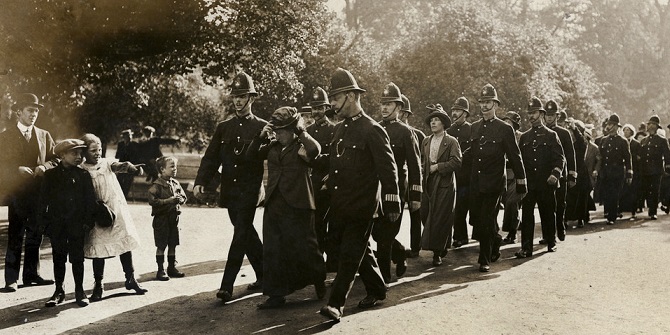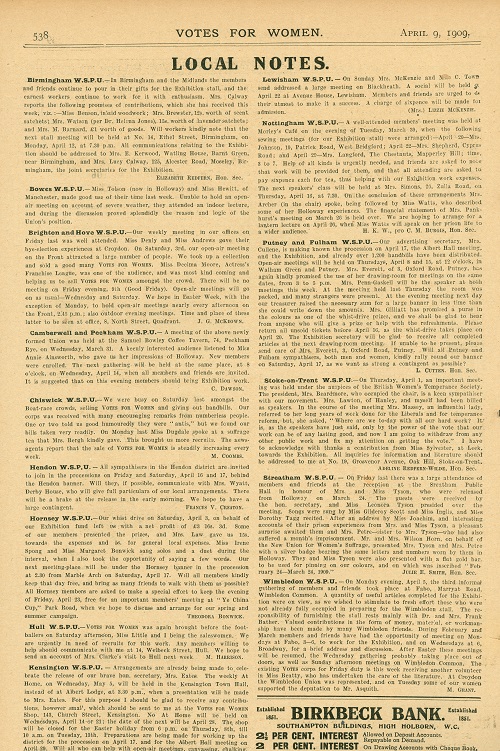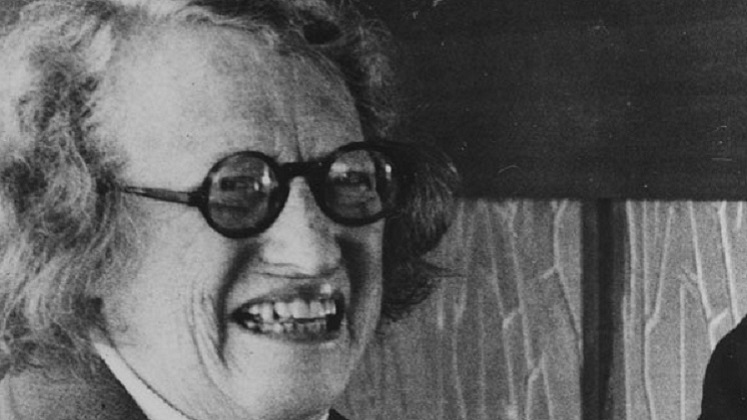LSE Library receives many enquiries from people who want to find out more about members of their family who were involved in the suffrage movement. Gillian Murphy looks at some of the resources available at LSE Library which might reveal information about a long-lost relative.

Historical background
The Women’s Library grew out of the work of London Society for Women’s Suffrage which was founded in 1867. The suffrage campaign was a very long campaign, beginning in 1866 with the presentation of the first mass women’s suffrage petition to Parliament, reaching a milestone in 1918 with the Representation of the People Act and ending in 1928 with the Equal Franchise Act when women were granted equal voting rights with men. By the 1920s the London Society had accumulated a tremendous amount of suffrage literature and it was decided that the collection should be managed on proper principles. In 1926 a library was founded called the Women’s Service Library, which was subsequently renamed the Fawcett Library in 1957 and the Women’s Library in 2002. LSE Library became custodians of the Women’s Library collection in 2013.
So where do you start with a name and the broad topic of suffrage?

Reference books
Elizabeth Crawford’s The Women’s Suffrage Movement. A reference guide 1866-1928 is an excellent starting point on any topic relating to suffrage. Its A-Z list of biographies of people and administrative histories of organisations involved in the suffrage movement are invaluable. There are also entries on suffrage jewellery and badges, newspapers and journals and suffrage clubs, for example. All entries are based on archival sources. Elizabeth Crawford’s companion volume, The Women’s Suffrage Movement in Britain and Ireland: a regional survey, provides a geographical dimension to the suffrage campaign at a local level. The Suffrage Annual and Women’s Who’s Who 1913 is another good reference work.
If you find a reference to your relation in one of Elizabeth Crawford’s reference books, then you are very lucky. If not, you can target your research by finding out which suffrage society your relation was a member of and what region of the country they were active in. Once you know this, then you will be able to locate minutes, annual reports and journals produced by that suffrage society, if they still exist, to see if your relation is mentioned in them.
Suffrage newspapers
Each of the major suffrage societies produced its own newspaper to spread its message and keep members up-to-date. Here is a list of the major suffrage societies with their newspaper titles:
| Suffrage Society | Newspaper |
| Central Committee of the National Society | Women’s Suffrage Journal (1870-1890) |
| East London Federation of Suffragettes | Women’s Dreadnought (1914-1924) |
| National Union for Women’s Suffrage Societies | The Common Cause (1909-1920) |
| National Union of Societies for Equal Citizenship | The Women’s Leader (1920-1932) |
| Women’s Social and Political Union | Votes for Women (1907-1918) |
| Women’s Social and Political Union | Suffragette (1912-1915) |
| Women’s Freedom League | The Vote (1909-1933) |
Suffrage newspapers are a rich source of information: listing names of subscribers to the newspaper (a good way of identifying suffrage supporters who weren’t necessarily high profile campaigners), giving news of events, articles from members, notices of meetings, both national and local, updates about other suffrage societies eg, Artists’ Suffrage League, conference reports, suffrage news from abroad, letters to the editor, reviews and advertisements. Particularly useful sections for gleaning suffrage activity in the regions are the “Forthcoming meetings” and “Federation Notes” sections.
Minutes and annual reports
Lilias Ashworth Hallett, a signatory of the 1866 women’s suffrage petition and committee member of the Bristol and West of England Society in 1867, wrote a letter to the Bursar of Girton College in 1903. Lilias recommended that annual reports of the early suffrage societies should be bound because ‘they have lists of all the early workers and early subscriptions and I believe that these will be of lasting interest.’ (Crawford, A Reference Guide, p 261. Girton College Archives ref GCAC 4/6/3/3]).
The Women’s Library collection does contain annual reports of the early suffrage societies in bound volumes within the Ruth Cavendish-Bentinck collection. Most, however, are loose copies. The collection also has annual reports and campaign papers of the NUWSS and the annual reports of the WSPU. Material can also be found scattered in personal papers of suffrage workers and might not be listed. Local record offices around the country will also hold copies of local NUWSS and WSPU annual reports. Annual reports and minutes often contain a wealth of information about an organisation’s activities. For example, there will often be lists of executive committee members, affiliated societies and honorary secretaries and reports of societies’ activities.
Further resources
Email LSE Library or use these LSE Library links:
Posts about LSE Library explore the history of the Library, our archives and special collections
Suffrage 18 is a series of posts to mark the 2018 centenary of the first votes for women, sharing stories from The Women’s Library about the campaign for women’s suffrage.






To Gillian Murphy, I will be visiting London, from Edinburgh, at the end of July and would like to find out more about my grandmother, a suffragette. She was Helen Mary Huggett nee McCarthy, born in 1857 in Ireland. She married Arthur Henry Richard in June 1896 in Kensington (she was 13 years older than him!) My dad remembered tea at Mrs Pankhurst’s and my Aunt Maire was dressed as an Irish colleen for suffragette marches! I’d love to know more about her, can you help? Could we meet in July?
Many thanks, Margaret Walker
Hi Margaret, I have passed your message on to GIllian. Thanks for getting in touch and good luck with the search! Hayley Reed, blog editor